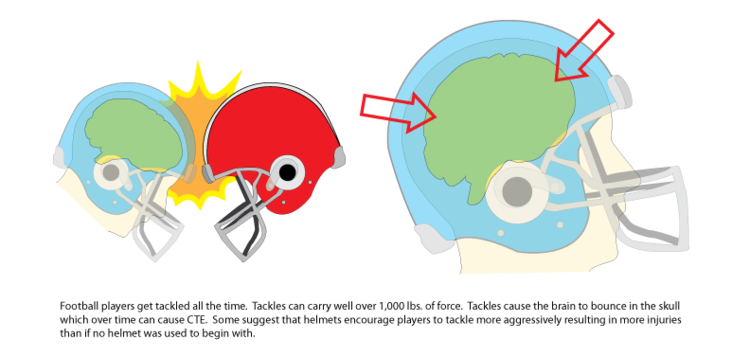
5 Easy Math Engagement Strategies for the Classroom
The news headlines are daunting. Math scores are down. School districts are scrambling to turn things around. And...
Science Explored | Published January 17, 2013
When you first hear the words “chronic traumatic encephalopathy (CTE),” you might dismiss it as a mouthful of healthcare jargon without any real personal significance. But if you or your loved ones have a history of playing impact sports like football, you may want to take notice. CTE describes a recently documented disease common to veteran football players. Wait…does football cause disease? No, this isn’t something picked up from exposure to a communal locker room, but rather the accumulation of thousands of blows to the head. CTE can cause memory loss, depression, dementia, and difficulty performing mental tasks; often these symptoms don’t appear until years after a football player has stopped playing. To understand the science behind CTE and some wild suggestions to help prevent it, let’s take a quick look at the history of football helmets.
Football helmets made their debut in the early 1900s with the innovation of hardened leather. Debate remains over who was the actual inventor of the football helmet because they were initially optional in professional games and few players wore them. It slowly became common to wear helmets because they provided some protection; the thick leather pads were designed to blunt blows on the forehead while cushioning the ears and rest of the skull. A mix between boxing headgear and wrestling ear guards provides a good visualization of the original football helmets.
In 1938, the Riddle Company completely changed football when they introduced plastic helmets. The Riddle Company had made a bet (not a scientific experiment) that plastic helmets would be safer than their leather cousins. Meanwhile, the NFL was making its own changes: by the mid-1940s, players were required to wear helmets. A few years later, players made the transition from their leather helmets to those from Riddle Company made of plastic. Nowadays, most of us would be stunned to see someone playing football without a helmet – what if they bumped heads? The irony is that maybe plastic helmets did not make the game safer as Riddle Company had intended.

If plastic helmets are supposed to make football safer, some might question why more and more players are being diagnosed with CTE. One reason is that, until a decade ago, we did not have the medical expertise and equipment to diagnose the disease. It is possible that a lot of players actually had it but were unaware. Nutrition science and sports training have come a long way since the 1900s; football players today are often bigger and stronger than their 1900s counterparts. Bigger and stronger = more force from tackling. The last reason is more complicated: the way football was played changed with the arrival of plastic helmets. Football players can get a false sense of safety while their heads are tucked in a big plastic dome. Fueled by competitiveness, players tackle their opposition and sometimes clash helmets with well over half a ton of force, according to professor Timothy Gay of University of Nebraska, author of The Physics of Football. In severe cases, these impacts cause concussions by making the brain bounce around in the skull. Buildup of trauma like this over time causes CTE.
What, then, is the solution? Should football helmets disappear tomorrow? The field is divided. “Some people have advocated for years to take the helmet off, take the face mask off. That’ll change the game dramatically,” said Fred Mueller, University of North Carolina professor studying brain injuries. Helmets were originally intended to prevent catastrophic head injuries like cracked skulls and broken jaws, concussions and resultant CTE that at the time were not understood. Others say that the solution lies in improving current helmets. Riddle Company, for example, has gone a long way in doing so since its prototypes add shock absorbing facemasks and feature inflatable padding zones. Still, many neurosurgeons agree that in order to really prevent concussions and CTE, helmets just need to be a whole lot bigger to fit in more padding. An entirely different approach would be to change the rules of football all together. But what would football be without tackling?
TEKS: 3.6B, 4.6D, 5.6D, 7.12B, 8.6C

The news headlines are daunting. Math scores are down. School districts are scrambling to turn things around. And...

Math assessment in California is changing. What used to be a compliance exercise or reporting tool is now becoming a...

You know the moment: a student’s eyes light up when the science experiment fizzes or the math puzzle helps them...